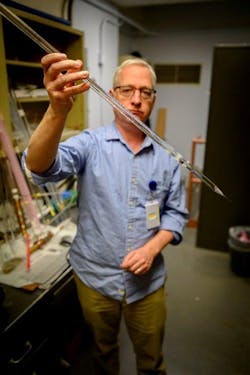Nano-Particles Increase Fiber Laser’s Power and Improve Eye Safety
Researchers at the U.S. Naval Research Laboratory have devised a new way to build powerful lasers that are more efficient and safer for your eyes by using nano-particles. The particles are used to create “rare-earth-ion-doped fiber,” which is silica fiber infused with ions of the rare-earth element holmium. The material lets the laser get to 85% efficiency.
The lasing process relies on a pump source (most often another laser), which excites the rare earth ions, which then emit photons to produce a high-quality light for lasing at the desired wavelength, according to Colin Baker, research chemist with the Lab’s Optical Materials and Devices Branch. “But this process has a penalty,” says Baker. “It’s never 100% efficient. What you’re putting in is pump energy, not the high-quality light at the wavelength you want. What’s coming out is a much higher quality of light at the specific wavelength you want, but energy that isn’t converted into laser light is wasted and converted into heat.”
That loss of energy, Baker explains, ultimately limits power scaling and the laser’s quality, which makes efficiency especially important.
With the doping from the nanoparticles, the laser can reach 85% efficiency with a laser that operates at a 2-micron wavelength, which is considered a safer wavelength for eyes than traditional 1-micron lasers. Of course, Baker points out, no laser is really safe when it comes to the human eye.
Colin Baker of the U.S. Naval Research Laboratory holds a silica glass rod (an optical preform) that has been infused with a holmium slurry and will be pulled into a doped optical fiber suitable for producing a more eye-friendly laser. (Courtesy: Jonathan Steffen)
The danger arises from the risk of scattered light being reflected into the eye during a laser’s operation. Scattered light from a 100-kW laser operating at 1 micron can significantly damage the retina and lead to blindness in that eye. With an “eye-safer” laser operated at wavelengths beyond 1.4 micron, however, the danger from scattered light is considerably reduced.
The nano-particle doping also solves several other problems. One is that it shields the rare earth ions from the silica. At 2 microns, silica’s glassy structure reduces the light output from the rare earth ions. The nanoparticle doping also separates the rare-earth ions from each other, which is helpful because packing them closely together can reduce the light output. Traditional lasers that operate at 1 micron using an ytterbium dopant aren’t nearly as affected by these factors, Baker says.
“The solution was some clever chemistry that dissolved holmium in a nano-powder of lutetia or lanthanum oxide or lanthanum fluoride to create a suitable crystal environment for the rare earth ions,” Sanghera says.
The particles of the nano-particle powder, which Sanghera’s team had originally synthesized for a previous project, are typically less than 20 nanometers.
“Additionally, we had to be able to dope nano-powders into the silica fiber in quantities that would be suitable to lasing,” he adds.
To create the doped fiber, the researchers are using a large glass-working lathe in which the glass that will eventually become the fiber is cleaned with fluorine gases, molded with a blowtorch, and infused with the nano-particle mixture, what the scientists call a “nanoparticle slurry.” The result is a rare-earth-ion-doped, one-inch diameter glass rod, or “optical preform.”
Next, scientists use a fiber pulling device to soften the preform with a furnace and elongate it in a process akin to pulling taffy. The resulting optical fiber is about as thin as a human hair, which then gets spooled onto a nearby large spindle.
Sanghera’s team has already submitted a patent application for the process. Among the potential applications they envision for the new fiber laser are high-powered lasers and amplifiers for defense, telecommunications, and even welding and laser-cutting.
“From a fundamental perspective, the whole process is commercially viable,” Sanghera said. “It’s a low-cost process to make the powder and incorporate it into the fiber. The process is similar to making telecom fiber.”

